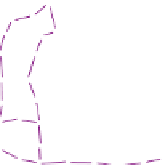Information Technology Reference
In-Depth Information
Request zone
for z
v
W
N
E
S
u
y
x
z
grid-head
sensor
Request path
r
Request zone
for y
Relocation path
Fig. 6.7
A general view of how (
a
) quorum based (
b
) ZONER (
c
) MSRP approach works
Variant of the quorum-based location service is the localized sensor relocation
protocols
ZONER (
zone-based sensor relocation protocol), proposed in [
25
]. In
ZONER, redundant sensors distribute their location information within a vertical
registration zone. After a node failure, two specified neighbors (on both the right
and left sides) query sensors within their bounded horizontal request zones for the
nearest redundant node. Thus, the discovered redundant node is relocated by shifted
movement (as replacement to the position of the failed node along a natural migra-
tion path). Since the algorithm does not use network-wide flooding, and because
only selected nodes are required to move, ZONER is both bandwidth and energy
efficient (Fig.
6.7b
).
In mesh-based sensor relocation protocol (
MSRP
), proposed in [
26
], redundant
sensors choose the nearest non-redundant sensors to act as a proxy node running the
iMesh algorithm (distance-sensitive service discovery algorithm) on their behalf to
construct an information mesh. When a node fails, the four neighbors search in four
directions to discover nearby proxies. The nearest detected redundant sensor of the
closest discovered proxy node is then relocated (by shifted movements) to replace
the failed node along an energy-aware migration path (Fig.
6.7c
).
According to the authors, both ZONER and MSRP outperform the existing sen-
sor relocation protocols (the quorum- and proxy-based approaches) because of their
localized message transmission, zero requirement of pre-knowledge of the network,
and guaranteed node replacement. Moreover, MSRP is also better than similar
algorithms (including ZONER) that rely on shifted replacement migration for their
novel localized migration path discovery.
6.3.1.4
Grid Structure Approaches
Different approaches for sensor self-deployment and relocation use various types
of
grid structures
on top of the physical infrastructure. In this manner, appropriate
basis for sensor movement algorithms application can be defined. The cost of orga-
nizing sensors into grids is low, and it is an easy method for facilitation of data
aggregation and routing.
The existing literature offers approaches where the sensor area is divided into two
dimensional evenly partitioned grid structures [
27, 28
], or in hexagonal grids [
1, 29
].
A novel approach using triangle tessellation (TT) layout is derived in [
30
].























































































































































































































































































































Search WWH ::

Custom Search